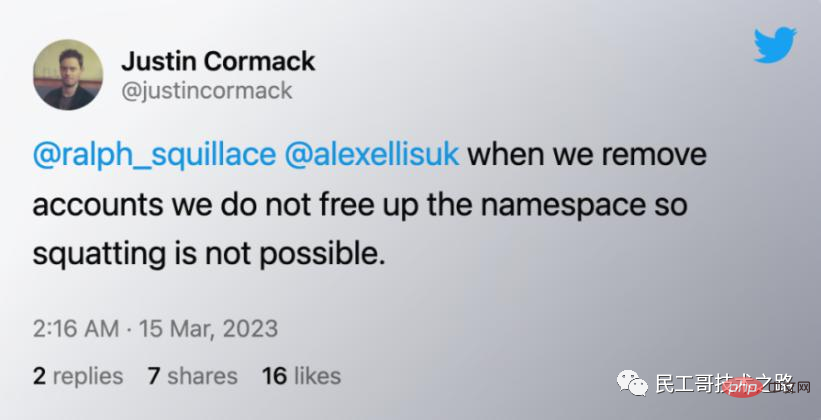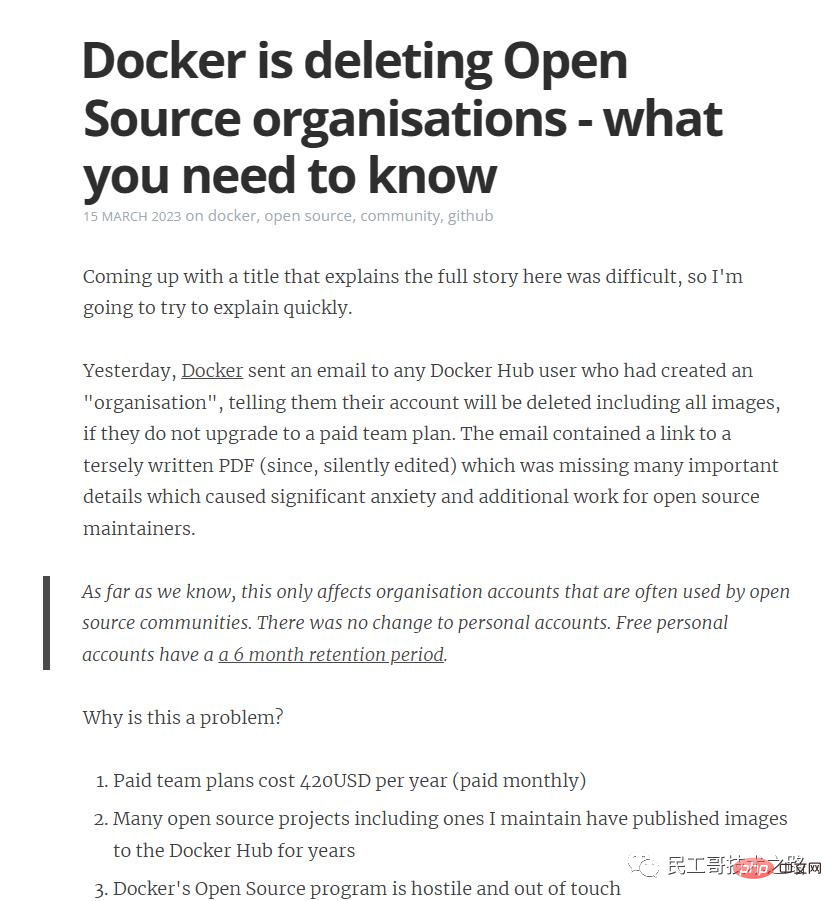Docker is no longer open source!
Docker’s eating looks are getting more and more ugly.
On March 15, Docker sent an email to all Docker Hub users who have created an "organization", reminding them that they must upgrade to the paid team plan of $420 per year, otherwise, the Docker image of their account Will be deleted.
It can be learned from the official FAQ that the groups affected by this adjustment are open source organization accounts, including Docker individuals, Docker Pro, Docker Team or Docker Business accounts, Docker-sponsored open source members, and Docker verified releases and Docker's official images are not affected.
The text of the email is roughly as follows
Docker is retiring Free Team Organizations because this free feature has many of the same features, rates, and functionality as the paid Docker Team subscription;
After reviewing a list of accounts that were members of legacy Free Team Organizations, we have determined that you may be one of them. If you are using an older version of Free Team Organizations, access to all paid features (including private repositories) will be suspended on April 14, 2023 (11:59 PM UTC). You will need to upgrade your subscription (and by implication pay) before April 14, 2023 to continue accessing your organization;
If you do not upgrade to a paid subscription, Docker will retain your organization's data for 30 days, after which it will be deleted. Your access to public repositories will be retained during this period, but will be rate limited;
If you upgrade to a paid subscription, you can restore access to your organization's account at any time within 30 days.
牛逼啊!接私活必备的 N 个开源项目!赶快收藏
As we all know, Docker Hub is used by many open source projects to publish images, and most projects rely on free images. If the images are deleted, it will have a huge impact on accounts under free organizations.
As soon as the news broke, it caused huge controversy, and many people began to migrate their images out of Docker to other platforms or host them themselves. Subsequently, Docker CTO stated directly on Twitter: "Those accounts that do not pay will be closed and no one else will be allowed to take over the name."  (Picture source: Twitter screenshot)
(Picture source: Twitter screenshot)
Die-hard supporters posted a long article accusing Docker of hypocrisy
As a die-hard supporter of Docker, the "Docker Captains" Loyal member Alex Ellis posted a lengthy complaint on his blog. As a paying user himself, he is not opposed to Docker making money, but Docker's communication methods and effects are terrible, creating anxiety for many of the most loyal and supportive community users. Their practice of using images to make open source exposes them This project is full of hostility and disjointed operation due to its hypocritical attitude towards open source sustainability issues.  He said that the only hope at present is that organizations that obtain "open source" certification qualifications can be exempted from Docker "taxation", such as all projects owned by the Cloud Native Computing Foundation (CNCF) or the Apache Foundation. And cited the well-known open source project curl. This open source library is used on almost every Mac and Linux computer, and is even used by Docker itself, but it cannot escape this charging plan.
He said that the only hope at present is that organizations that obtain "open source" certification qualifications can be exempted from Docker "taxation", such as all projects owned by the Cloud Native Computing Foundation (CNCF) or the Apache Foundation. And cited the well-known open source project curl. This open source library is used on almost every Mac and Linux computer, and is even used by Docker itself, but it cannot escape this charging plan.
Feedback from Netizens
In addition to Alex Ellis’s lengthy complaint, it also triggered heated discussions among netizens on Hacker News and Twitter.
An SRE manager said bluntly: "When I saw this news in the morning, I felt a headache." Then he also mentioned: "In the next 30 days, a bunch of images that I rely on may disappear... "
Some netizens also joked: "Docker will eventually become someone else's wedding dress. I mean Containerized standard wedding dress", "free service that requires money to maintain" and "low risk" are incompatible. In addition, search the official account Linux Chinese community backend and reply "Linux" to get a surprise gift package.
However, some netizens have a more "optimistic" attitude towards Docker's approach, believing: "Docker is a tool that has advantages for software development. It is much better than the old method of managing dependencies and can Ensure that the version installed by everyone in the project is consistent."
In the past, with the development of cloud native, containerization, microservices, K8s and other technologies, Docker was widely used in the developer field. Today, Docker will delete all images of unpaid open source organizations, which will inevitably bring "discomfort" to developers. Although you can apply for free, the terms are very harsh.
What do you think of this measure of Docker?
The above is the detailed content of Docker is no longer open source!. For more information, please follow other related articles on the PHP Chinese website!

Hot AI Tools

Undresser.AI Undress
AI-powered app for creating realistic nude photos

AI Clothes Remover
Online AI tool for removing clothes from photos.

Undress AI Tool
Undress images for free

Clothoff.io
AI clothes remover

AI Hentai Generator
Generate AI Hentai for free.

Hot Article

Hot Tools

Notepad++7.3.1
Easy-to-use and free code editor

SublimeText3 Chinese version
Chinese version, very easy to use

Zend Studio 13.0.1
Powerful PHP integrated development environment

Dreamweaver CS6
Visual web development tools

SublimeText3 Mac version
God-level code editing software (SublimeText3)

Hot Topics
 1385
1385
 52
52
 How to update the image of docker
Apr 15, 2025 pm 12:03 PM
How to update the image of docker
Apr 15, 2025 pm 12:03 PM
The steps to update a Docker image are as follows: Pull the latest image tag New image Delete the old image for a specific tag (optional) Restart the container (if needed)
 How to create a mirror in docker
Apr 15, 2025 am 11:27 AM
How to create a mirror in docker
Apr 15, 2025 am 11:27 AM
Steps to create a Docker image: Write a Dockerfile that contains the build instructions. Build the image in the terminal, using the docker build command. Tag the image and assign names and tags using the docker tag command.
 How to use docker desktop
Apr 15, 2025 am 11:45 AM
How to use docker desktop
Apr 15, 2025 am 11:45 AM
How to use Docker Desktop? Docker Desktop is a tool for running Docker containers on local machines. The steps to use include: 1. Install Docker Desktop; 2. Start Docker Desktop; 3. Create Docker image (using Dockerfile); 4. Build Docker image (using docker build); 5. Run Docker container (using docker run).
 How to read the docker version
Apr 15, 2025 am 11:51 AM
How to read the docker version
Apr 15, 2025 am 11:51 AM
To get the Docker version, you can perform the following steps: Run the Docker command "docker --version" to view the client and server versions. For Mac or Windows, you can also view version information through the Version tab of the Docker Desktop GUI or the About Docker Desktop menu.
 How to check the name of the docker container
Apr 15, 2025 pm 12:21 PM
How to check the name of the docker container
Apr 15, 2025 pm 12:21 PM
You can query the Docker container name by following the steps: List all containers (docker ps). Filter the container list (using the grep command). Gets the container name (located in the "NAMES" column).
 How to copy files in docker to outside
Apr 15, 2025 pm 12:12 PM
How to copy files in docker to outside
Apr 15, 2025 pm 12:12 PM
Methods for copying files to external hosts in Docker: Use the docker cp command: Execute docker cp [Options] <Container Path> <Host Path>. Using data volumes: Create a directory on the host, and use the -v parameter to mount the directory into the container when creating the container to achieve bidirectional file synchronization.
 How to save docker image
Apr 15, 2025 am 11:54 AM
How to save docker image
Apr 15, 2025 am 11:54 AM
To save the image in Docker, you can use the docker commit command to create a new image, containing the current state of the specified container, syntax: docker commit [Options] Container ID Image name. To save the image to the repository, you can use the docker push command, syntax: docker push image name [: tag]. To import saved images, you can use the docker pull command, syntax: docker pull image name [: tag].
 How to change the docker image source in China
Apr 15, 2025 am 11:30 AM
How to change the docker image source in China
Apr 15, 2025 am 11:30 AM
You can switch to the domestic mirror source. The steps are as follows: 1. Edit the configuration file /etc/docker/daemon.json and add the mirror source address; 2. After saving and exiting, restart the Docker service sudo systemctl restart docker to improve the image download speed and stability.




